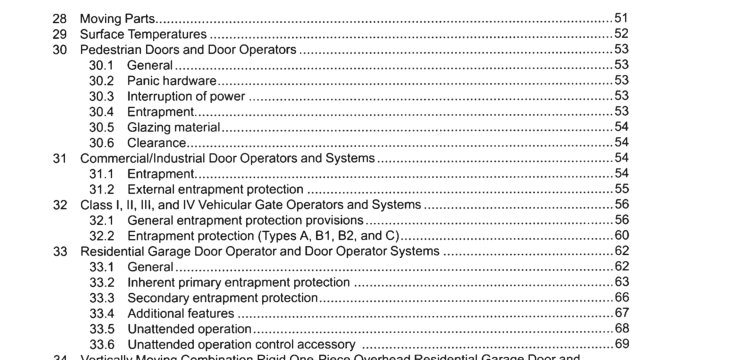UL 325-2019 pdf download.Door, Drapery, Gate, Louver, and Window Operators and Systems.
4.1 1 GATE – A moving barrier such as a swinging, sliding, raising, lowering, rolling, or the like, barrier, that is a stand-alone passage barrier or is that portion of a wall or fence system that controls entrance and/ or egress by persons or vehicles and completes the perimeter of a defined area. 4.1 2 INDUSTRIAL/LIMITED ACCESS VEHICULAR GATE OPERATOR – CLASS III – A vehicular gate operator (or system) intended for use in an industrial location or building such as a factory or loading dock area or other locations not accessible by or intended to service the general public. 4.1 3 INHERENT ENTRAPMENT PROTECTION SYSTEM – A system, examples being a motor current or speed sensing system, which provides protection against entrapment upon sensing an object and is incorporated as a permanent and integral part of an operator. 4.1 4 LIGHT DUTY (COMMERCIAL/INDUSTRIAL) VEHICULAR GATE OPERATOR (OR SYSTEM) – A commercial or industrial Class II, III, or IV vehicular gate operator (or system) intended and marked for limited or restricted duty. 4.1 5 LIGHT DUTY (COMMERCIAL/INDUSTRIAL) DOOR OPERATOR (OR SYSTEM) – A commercial/ industrial door operator (or system) intended and marked for limited or restricted duty. Doors used to secure store fronts and intended for pedestrian use, but usually operated only at the start and end of the business day are included. Doors used solely for pedestrian access and egress which open and close for each pedestrian or group of pedestrians are not covered by this definition.
4.1 6 LINE OF SIGHT -Visible and not more that 1 5m (50 ft) distance between the control and the door. 4.1 7 LOUVER OPERATOR (OR SYSTEM) – An operator (or system) intended to open and close louvers or shutters used for ventilation or as window coverings. 4.1 8 PEDESTRIAN DOOR OR GATE OPERATOR (OR SYSTEM) – A swinging, sliding, biparting, folding, or rotating door or gate operator (or system) that is used at pedestrian entrances or exits to buildings or other pedestrian traffic ways. They are not used for vehicular traffic. 4.1 9 RESIDENTIAL GARAGE-DOOR OPERATOR – A vehicular door operator serving a residential building of one to four single family units. 4.20 RESIDENTIAL VEHICULAR GATE OPERATOR – CLASS I – A vehicular gate operator (or system) intended for use in garages or parking areas associated with a residence of one-to four single families . 4.21 RESTRICTED ACCESS VEHICULAR GATE OPERATOR – CLASS IV – A vehicular gate operator (or system) intended for use in a guarded industrial location or building such as an airport security area or other restricted access locations not servicing the general public, in which unauthorized access is prevented via supervision by security personnel. 4.22 SENSING AN OBSTRUCTION – The detection of an obstruction resulting in commanding a door or gate operator to react, for example, opening a relay in response to detecting an obstruction by an edge sensor. In the event the obstruction is communicated to the operator control via electronic transmission, including wireless communication, sensing an obstruction occurs at the initial detection of the obstruction.
4.25 SYSTEM – In the context of these requirements, a system refers to a group of interacting devices intended to perform a common function. 4.26 TWO SEQUENTIAL ACTIVATIONS – Two activations of an entrapment protection device that are not interrupted by an open or close limit device. 4.27 UNATTENDED OPERATION, RESIDENTIAL GARAGE DOOR OPERATOR – Operation without the user within the line-of-sight of the door. 4.28 VEHICULAR BARRIER (ARM) OPERATOR (OR SYSTEM) – An operator (or system) that controls a cantilever type device (or system), consisting of a mechanical arm or barrier that moves in a vertical arc, intended for vehicular traffic flow at entrances or exits to areas such as parking garages, lots or toll areas. 4.29 VERTICAL PIVOT GATE ENTRAPMENT ZONE – Locations between a moving gate or exposed operator components and a counter opposing edge or surface where entrapment is possible. Such locations occur when the gap between a moving gate and fixed counter opposing edges or surfaces, other than the ground or floor at the bottom of the gate, is greater than 57.2 mm (2.25 in) and less than 406 mm (1 6 in) on the public side of the gate, or on the private side of the gate is greater than 1 01 .6 mm (4 in) and less than 406 mm (1 6 in), or when the gap between a moving gate and fixed counter opposing edges or surfaces at the bottom of the gate is less than 406 mm (1 6 in). 4.30 VEHICULAR HORIZONTAL SLIDE-GATE OPERATOR (OR SYSTEM) – A vehicular gate operator (or system) that controls a gate which slides in a horizontal direction that is intended for use for vehicular entrance or exit to a drive, parking lot, or the like.UL 325-2019 pdf download.
UL 325-2019 pdf download
